Highly Birefringent and Low-Loss Hollow-Core Anti-Resonant Fiber Based on a Hybrid Guidance Mechanism
Abstract
1. Introduction
2. Fiber Structure and Performance Analysis
3. Discussion and Conclusions
Author Contributions
Funding
Institutional Review Board Statement
Informed Consent Statement
Data Availability Statement
Acknowledgments
Conflicts of Interest
References
- Mousavi, S.A.; Richardson, D.J.; Sandoghchi, S.R.; Poletti, F. First design of high birefringence and polarising hollow core anti-resonant fiber. In Proceedings of the 2015 41th European Conference on Optical Communication (ECOC), Valencia, Spain, 27 September–1 October 2015; pp. 1–3. [Google Scholar] [CrossRef]
- Hasan, M.I.; Razzak, S.A.; Habib, M.S. Design and Characterization of Highly Birefringent Residual Dispersion Compensating Photonic Crystal Fiber. J. Light. Technol. 2014, 32, 3976–3982. [Google Scholar] [CrossRef]
- Yang, T.; Wang, E.; Jiang, H.; Hu, Z.; Xie, K. High Birefringence Photonic Crystal Fiber with High Nonlinearity and Low Confinement Loss. Opt. Express 2015, 23, 8329–8337. [Google Scholar] [CrossRef] [PubMed]
- Gui, F.; Jiang, P.; Yang, H.; Qin, Y.; Caiyang, W. Design for a High Birefringence Photonic Crystal Fiber with Multimode and Low Loss. Appl. Opt. 2018, 57, 6–13. [Google Scholar] [CrossRef] [PubMed]
- Prabu, K.; Malavika, R. Highly birefringent photonic crystal fiber with hybrid cladding. Opt. Fiber Technol. 2019, 47, 21–26. [Google Scholar] [CrossRef]
- Lee, Y.S.; Hong, S.; Kim, S.E.; Oh, K. Dense double-cladding photonic crystal fiber with high birefringence, large negative dispersion and high nonlinearity. In Proceedings of the 2018 23rd Opto-Electronics and Communications Conference (OECC), Jeju, Republic of Korea, 2–6 July 2018; pp. 1–2. [Google Scholar] [CrossRef]
- Agbemabiese, P.A.; Akowuah, E.K. Numerical analysis of photonic crystal fiber of ultra-high birefringence and high nonlinearity. Sci. Rep. 2020, 10, 21182. [Google Scholar] [CrossRef]
- Hosen, M.S.; Khaleque, A.; Shaha, K.S.R.; Nishad, R.; Sultana, A.S. Highly Birefringent Low Losses Hollow-Core Anti-resonant Fiber. In Proceedings of the 3rd International Conference on Electrical & Electronic Engineering (ICEEE), Rajshahi, Bangladesh, 22–24 December 2021; pp. 141–144. [Google Scholar] [CrossRef]
- Mousavi, S.A.; Sandoghchi, S.R.; Richardson, D.J.; Poletti, F. Broadband high birefringence and polarizing hollow core antiresonant fibers. Opt. Express 2016, 24, 22943–22958. [Google Scholar] [CrossRef] [PubMed]
- Guo, Y.; Wang, X.; Xing, Z.; Lou, S. Hybrid hollow-core polarization-maintaining fiber with high birefringence and wide single mode bandwidth. Results Phys. 2021, 29, 104725–104731. [Google Scholar] [CrossRef]
- Michieletto, M.; Lyngsø, J.K.; Jakobsen, C.; Lægsgaard, J.; Bang, O.; Alkeskjold, T.T. Hollow-core fibers for high power pulse delivery. Opt. Express 2016, 24, 7103–7119. [Google Scholar] [CrossRef]
- Knight, J.C.; Broeng, J.; Birks, T.A.; Russell, P.S.J. Photonic band gap guidance in optical fibers. Science 1998, 282, 1476–1478. [Google Scholar] [CrossRef]
- Wei, C.; Menyuk, C.R.; Hu, J. Polarization-filtering and polarization-maintaining low-loss negative curvature fibers. Opt. Express 2018, 26, 9528–9540. [Google Scholar] [CrossRef]
- Saitoh, K.; Koshiba, M. Photonic bandgap fibers with high birefringence. IEEE Photon. Technol. Lett. 2002, 282, 1291–1293. [Google Scholar] [CrossRef]
- Bouwmans, G.; Luan, F.; Knight, J.C.; Russell, P.S.J.; Farr, L.; Mangan, B.J.; Sabert, H. Properties of a hollow-core photonic bandgap fiber at 850 nm wavelength. Opt. Express 2003, 11, 1613–1620. [Google Scholar] [CrossRef] [PubMed]
- Chen, X.; Li, M.J.; Venkataraman, N.; Gallagher, M.T.; Wood, W.A.; Crowley, A.M.; Carberry, J.; Zenteno, L.A.; Koch, K.W. Highly birefringent hollow-core photonic bandgap fiber. Opt. Express 2004, 12, 3888–3893. [Google Scholar] [CrossRef] [PubMed]
- Fini, J.M.; Nicholson, J.W.; Mangan, B.; Meng, L.; Windeler, R.S.; Monberg, E.M.; DeSantolo, A.; DiMarcello, F.V.; Mukasa, K. Polarization maintaining single-mode low-loss hollow-core fibers. Nat. Commun. 2014, 5, 5085–5091. [Google Scholar] [CrossRef]
- Hong, Y.F.; Gao, S.F.; Ding, W.; Zhang, X.; Jia, A.Q.; Sheng, Y.L.; Wang, P.; Wang, Y.Y. Highly Birefringent Anti-Resonant Hollow-Core Fiber with a Bi-Thickness Fourfold Semi-Tube Structure. Laser Photonics Rev. 2022, 16, 2100365–2100373. [Google Scholar] [CrossRef]
- Zhao, X.; Xiang, J.; Wu, X.; Li, Z. High birefringence, single-polarization, low loss hollow-core anti-resonant fibers. Opt. Express 2021, 29, 36273–36286. [Google Scholar] [CrossRef]
- Markos, C.; Travers, J.C.; Abdolvand, A.; Eggleton, B.J.; Bang, O. Hybrid photonic-crystal fiber. Rev. Mod. Phys. 2017, 89, 045003–045060. [Google Scholar] [CrossRef]
- Wang, Y.; Dasa, M.K.; Adamu, A.I.; Antonio-Lopez, J.E.; Habib, M.S.; Amezcua-Correa, R.; Bang, O.; Markos, C. High pulse energy and quantum efficiency mid-infrared gas Raman fiber laser targeting CO2 absorption at 4.2 µm. Opt. Lett. 2020, 45, 1938–1941. [Google Scholar] [CrossRef]
- Wang, Y.; Feng, Y.; Adamu, A.I.; Dasa, M.K.; Antonio-Lopez, J.E.; Amezcua-Correa, R.; Markos, C. Mid-infrared photoacoustic gas monitoring driven by a gas-filled hollow-core fiber laser. Sci. Rep. 2021, 11, 3512–3519. [Google Scholar] [CrossRef]
- Li, M.; Singh, R.; Soares, M.S.; Marques, C.; Zhang, B.; Kumar, S. Convex fiber-tapered seven core fiber-convex fiber (CTC) structure-based biosensor for creatinine detection in aquaculture. Opt. Express 2022, 30, 13898–13914. [Google Scholar] [CrossRef]
- Li, M.; Singh, R.; Marques, C.; Zhang, B.; Kumar, S. 2D material assisted SMF-MCF-MMF-SMF based LSPR sensor for creatinine detection. Opt. Express 2021, 29, 38150–38167. [Google Scholar] [CrossRef] [PubMed]
- Wang, Y.; Singh, R.; Li, M.; Min, R.; Wu, Q.; Kaushik, B.K.; Jha, R.; Zhang, B.; Kumar, S. Cardiac Troponin I Detection using Gold/Cerium-Oxide Nanoparticles assisted Hetro-Core Fiber Structure. IEEE Trans. NanoBioscience 2022, 22, 375–382. [Google Scholar] [CrossRef] [PubMed]
- Hua, Y.; Wang, R.; Li, D. A Fiber-Based SPR Aptasensor for the In Vitro Detection of Inflammation Biomarkers. Micromachines 2022, 13, 1036–1046. [Google Scholar] [CrossRef] [PubMed]
- Wang, Z.; Singh, R.; Marques, C.; Jha, R.; Zhang, B.; Kumar, S. Taper-in-taper fiber structure-based LSPR sensor for alanine aminotransferase detection. Opt. Express 2021, 29, 43793–43810. [Google Scholar] [CrossRef]
- Zhu, G.; Wang, Y.; Wang, Z.; Singh, R.; Marques, C.; Wu, Q.; Kaushik, B.K.; Jha, R.; Zhang, B.; Kumar, S. Localized plasmon-based multicore fiber biosensor for acetylcholine detection. IEEE Trans. Instrum. Meas. 2021, 71, 1–9. [Google Scholar] [CrossRef]
- Liu, X.; Singh, R.; Li, M.; Li, G.; Min, R.; Marques, C.; Zhang, B.; Kumar, S. Plasmonic sensor based on offset-splicing and waist-expanded taper using multicore fiber for detection of Aflatoxins B1 in critical sectors. Opt. Express 2023, 31, 4783–4802. [Google Scholar] [CrossRef]
- Wang, Y.; Singh, R.; Zhang, B.; Kumar, S. Tapered MMF/AuNPs/MoS2-NPs based sensor for p-cresol detection. In Proceedings of the 2021 SPIE/COS Photonics Asia, Nantong, China, 10–13 October 2021; pp. 1190303–1190308. [Google Scholar] [CrossRef]
- Wang, Y.; Zhu, G.; Li, M.; Singh, R.; Marques, C.; Min, R.; Kaushik, B.K.; Zhang, B.; Jha, R.; Kumar, S. Water pollutants p-cresol detection based on Au-ZnO nanoparticles modified tapered optical fiber. IEEE Trans. Nanobioscience 2021, 20, 377–384. [Google Scholar] [CrossRef]
- Habib, M.S.; Adamu, A.I.; Markos, C.; Amezcua-Correa, R. Enhanced birefringence in conventional and hybrid anti-resonant hollow-core fibers. Opt. Express 2021, 29, 12516–12530. [Google Scholar] [CrossRef]
- Poletti, F. Nested antiresonant nodeless hollow core fiber. Opt. Express 2014, 22, 23807–23828. [Google Scholar] [CrossRef]
- Pryamikov, A.D.; Biriukov, A.S.; Kosolapov, A.F.; Plotnichenko, V.G.; Semjonov, S.L.; Dianov, E.M. Demonstration of a waveguide regime for a silica hollow-core microstructured optical fiber with a negative curvature of the core boundary in the spectral region >3.5 µm. Opt. Express 2011, 19, 1441–1448. [Google Scholar] [CrossRef]
- Belardi, W.; Knight, J.C. Hollow antiresonant fibers with reduced attenuation. Opt. Lett. 2014, 39, 1853–1856. [Google Scholar] [CrossRef] [PubMed]
- Habib, M.S.; Bang, O.; Bache, M. Low-loss hollow-core silica fibers with adjacent nested anti-resonant tubes. Opt. Express 2015, 23, 17394–17406. [Google Scholar] [CrossRef] [PubMed]
- Habib, M.S.; Bang, O.; Bache, M. Low-loss single-mode hollow-core fiber with anisotropic anti-resonant elements. Opt. Express 2016, 24, 8429–8436. [Google Scholar] [CrossRef]
- Habib, M.S.; Markos, C.; Antonio-Lopez, J.; Amezcua-Correa, R. Extreme UV light generation through dispersive wave trapping in a tapered gas-filled hollow fiber. IEEE Photonics Technol. Lett. 2019, 31, 795–798. [Google Scholar] [CrossRef]
- Adamu, A.I.; Habib, M.S.; Petersen, C.R.; Lopez, J.E.A.; Zhou, B.; Schülzgen, A.; Bache, M.; Amezcua-Correa, R.; Bang, O.; Markos, C. Deep-UV to mid-IR supercontinuum generation driven by mid-IR ultrashort pulses in a gas-filled hollow-core fiber. Sci. Rep. 2019, 9, 4446. [Google Scholar] [CrossRef] [PubMed]
- Sakr, H.; Hong, Y.; Bradley, T.; Jasion, G.; Hayes, J.; Kim, H.; Davidson, I.; Fokoua, E.N.; Chen, Y.; Bottrill, K.; et al. Interband short reach data transmission in ultrawide bandwidth hollow core fiber. J. Light. Technol. 2020, 38, 159–165. [Google Scholar] [CrossRef]
- Jasion, G.T.; Bradley, T.D.; Harrington, K.; Sakr, H.; Chen, Y.; Fokoua, E.N.; Davidson, I.A.; Taranta, A.; Hayes, J.R.; Richardson, D.J.; et al. Hollow core NANF with 0.28 dB/km attenuation in the C and L bands. In Proceedings of the 2020 Optical Fiber Communication Conference (OFC), San Diego, CA, USA, 8–12 March 2020; p. Th4B–4. [Google Scholar] [CrossRef]
- Du, Z.; Zhou, Y.; Luo, S.; Zhang, Y.; Shao, J.; Guan, Z.; Yang, H.; Chen, D. Highly birefringent hollow-core anti-resonant terahertz fiber with a thin strut microstructure. Opt. Express 2022, 30, 3783–3792. [Google Scholar] [CrossRef]
- Zhang, S.; Sun, S.; Sheng, Q.; Shi, W.; Yan, Z.; Yao, J. Low-loss polarization-maintaining solid-core anti-resonant fiber in mid-infrared region. Results Phys. 2021, 26, 104439–104442. [Google Scholar] [CrossRef]
- Zhang, S.; Sun, S.; Sheng, Q.; Shi, W.; Yan, Z.; Tian, H.; Yao, J. Polarization-Maintaining Performance of Solid-Core Anti-Resonant Fiber with Nested Circular Tubes in 3 μm Wavelength. J. Light. Technol. 2022, 40, 1137–1143. [Google Scholar] [CrossRef]
- Debord, B.; Amsanpally, A.; Chafer, M.; Baz, A.; Benabid, F. Ultralow transmission loss in inhibited-coupling guiding hollow fibers. Optica 2017, 4, 209–217. [Google Scholar] [CrossRef]
- Huang, X.; Qi, W.; Ho, D.; Yong, K.T.; Luan, F.; Yoo, S. Hollow core anti-resonant fiber with split cladding. Opt. Express 2016, 24, 7670–7678. [Google Scholar] [CrossRef] [PubMed]
- Huang, X.; Yoo, S.; Yong, K. Function of second cladding layer in hollow core tube lattice fibers. Sci. Rep. 2017, 7, 1618–1626. [Google Scholar] [CrossRef] [PubMed]
- Debord, B.; Alharbi, M.; Benoît, A.; Ghosh, D.; Dontabactouny, M.; Vincetti, L.; Blondy, J.-M.; Gérôme, F.; Benabid, F. Ultra low-loss hypocycloid-core Kagome hollow-core photonic crystal fiber for green spectral-range applications. Opt. Lett. 2014, 39, 6245–6248. [Google Scholar] [CrossRef]
- Gao, S.F.; Wang, Y.Y.; Wei, D.; Jiang, D.L.; Shuai, G.; Zhang, X.; Pu, W. Hollow-core conjoined-tube negative-curvature fiber with ultralow loss. Nat. Commun. 2018, 9, 2828–2833. [Google Scholar] [CrossRef] [PubMed]
- Jaworski, P.; Yu, F.; Carter, R.M.; Knight, J.C.; Shephard, J.D.; Hand, D.P. High energy green nanosecond and picosecond pulse delivery through a negative curvature fiber for precision micro-machining. Opt. Express 2015, 23, 8498–8506. [Google Scholar] [CrossRef]
- Wang, Y.Y.; Wheeler, N.V.; Couny, F.; Roberts, P.J.; Benabid, F. Low loss broadband transmission in hypocycloid-core Kagome hollow-core photonic crystal fiber. Opt. Lett. 2011, 36, 669–671. [Google Scholar] [CrossRef]
- Liu, S.; Li, Y.; Ma, R.; Zhao, L.; Lv, J.; Dong, X. Study on the High-Birefringence Hollow-Core Anti-Resonant Fiber with Semicircular Cladding. Int. J. Opt. 2021, 2021, 5520142. [Google Scholar] [CrossRef]

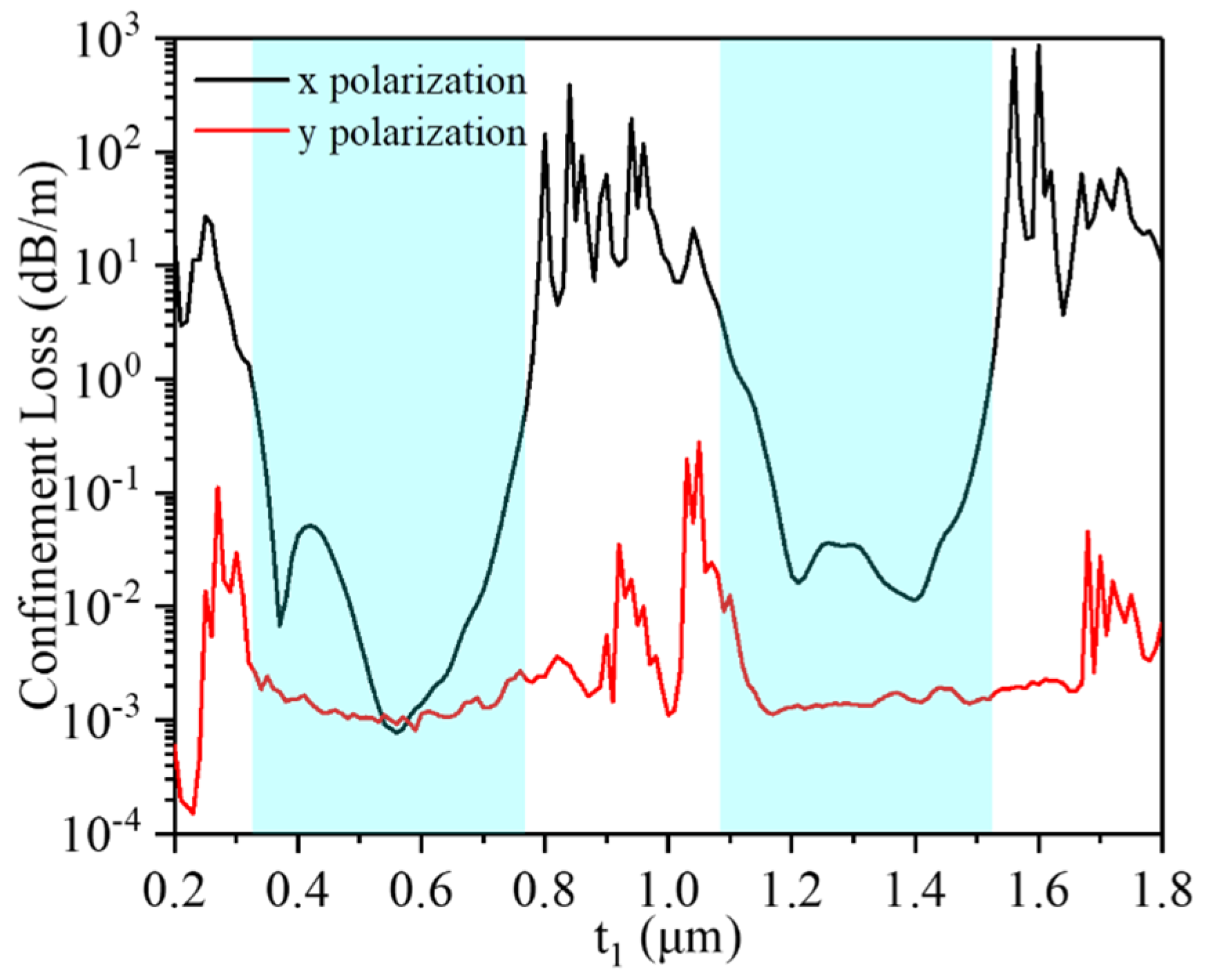
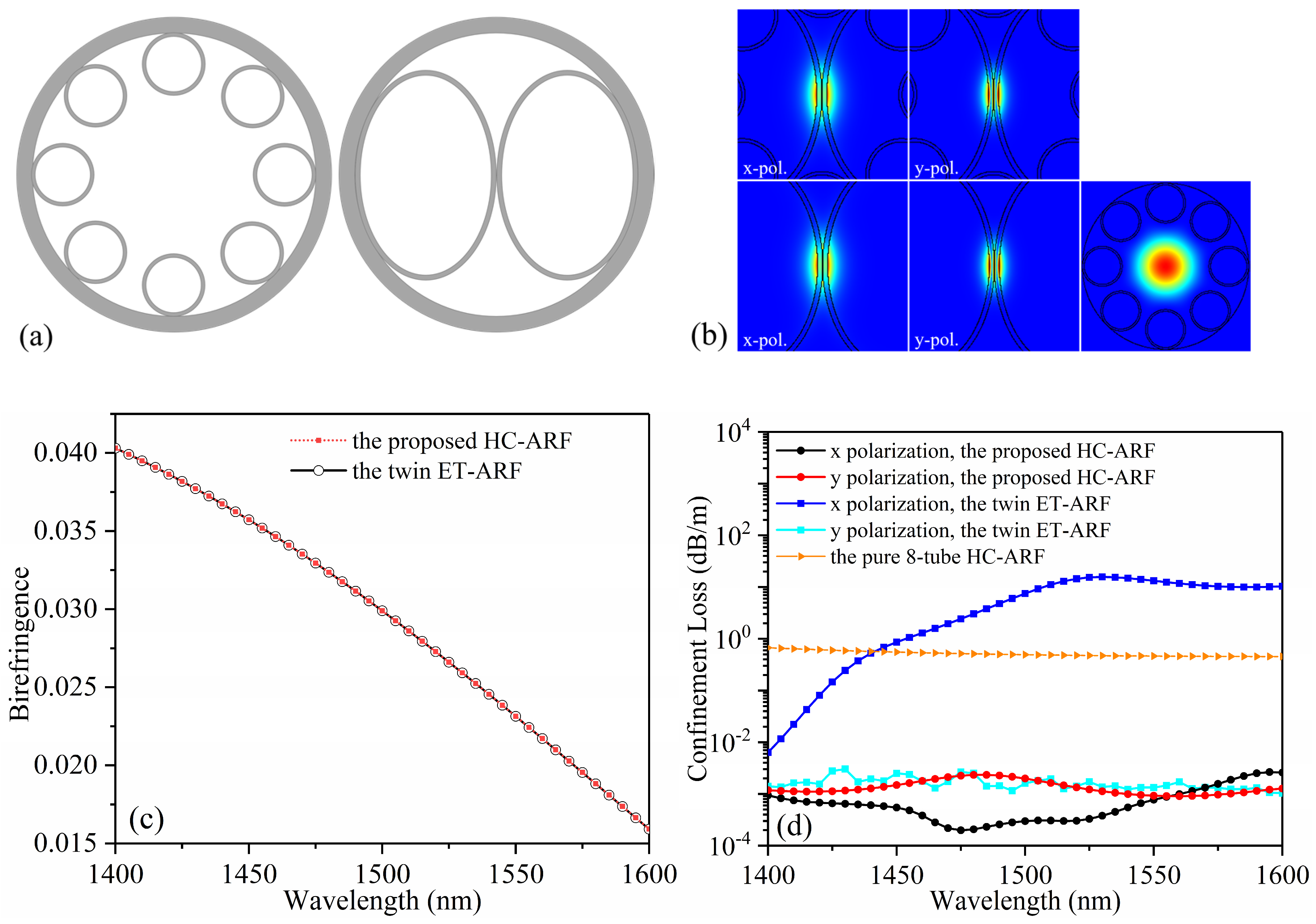



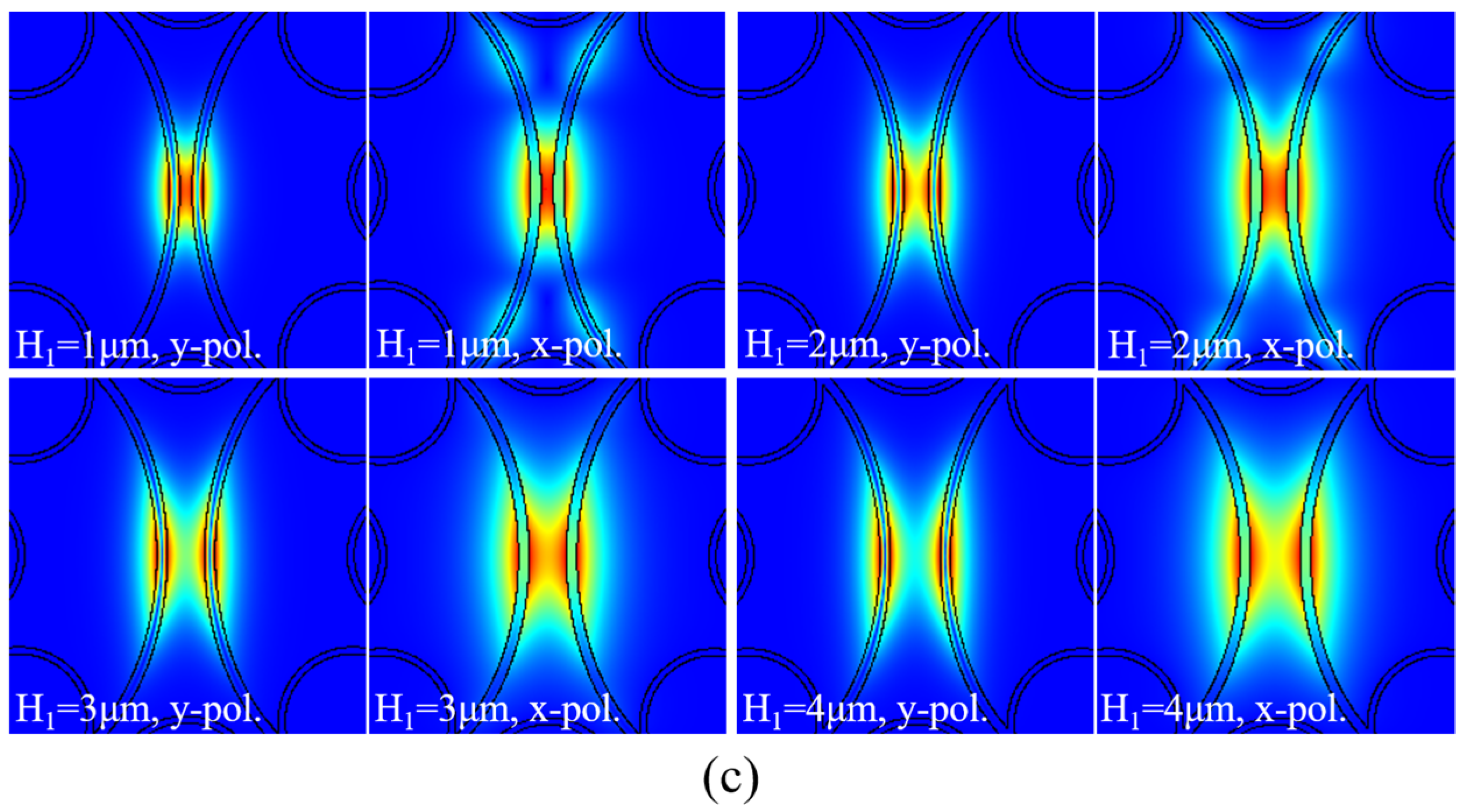
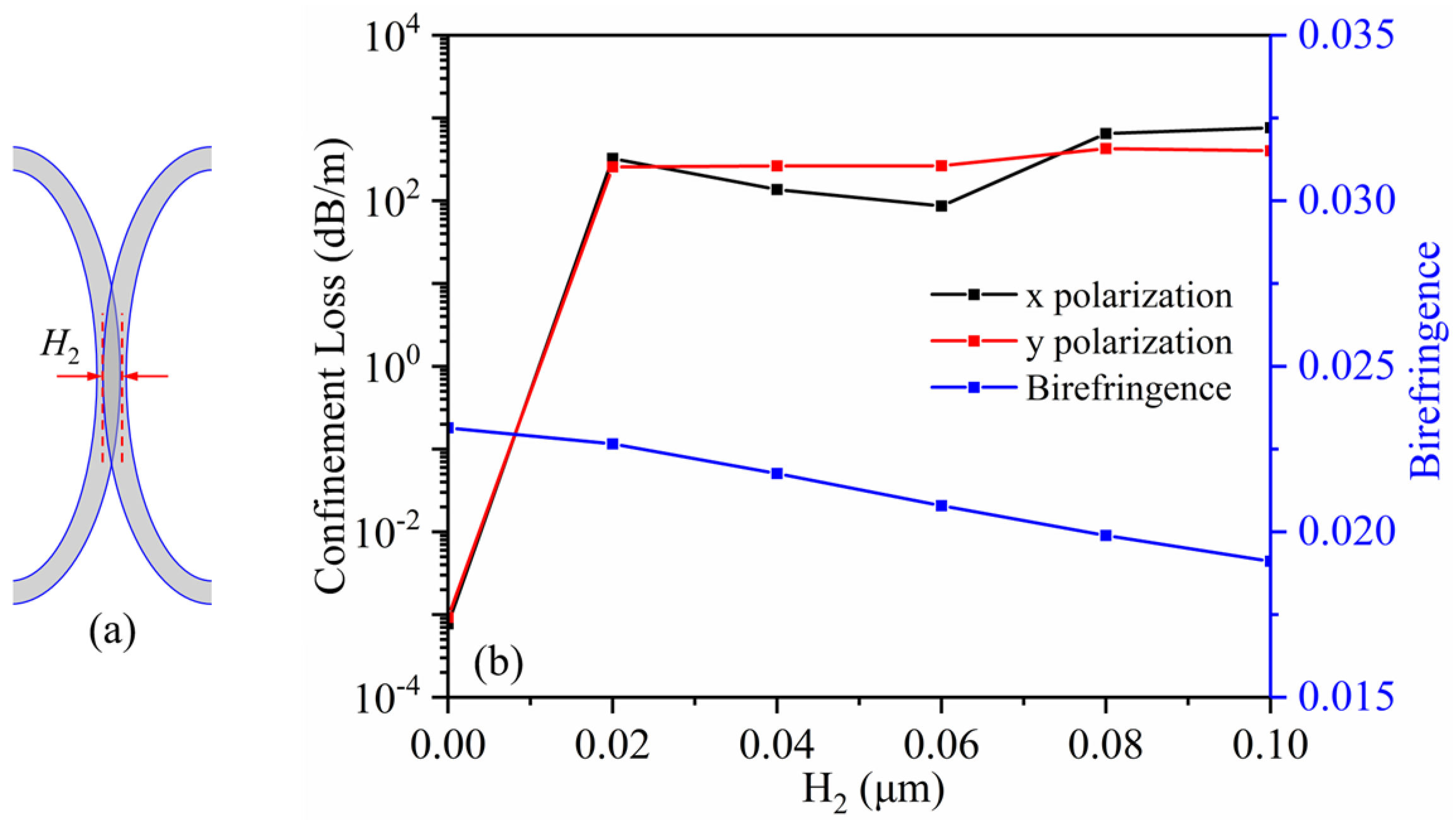
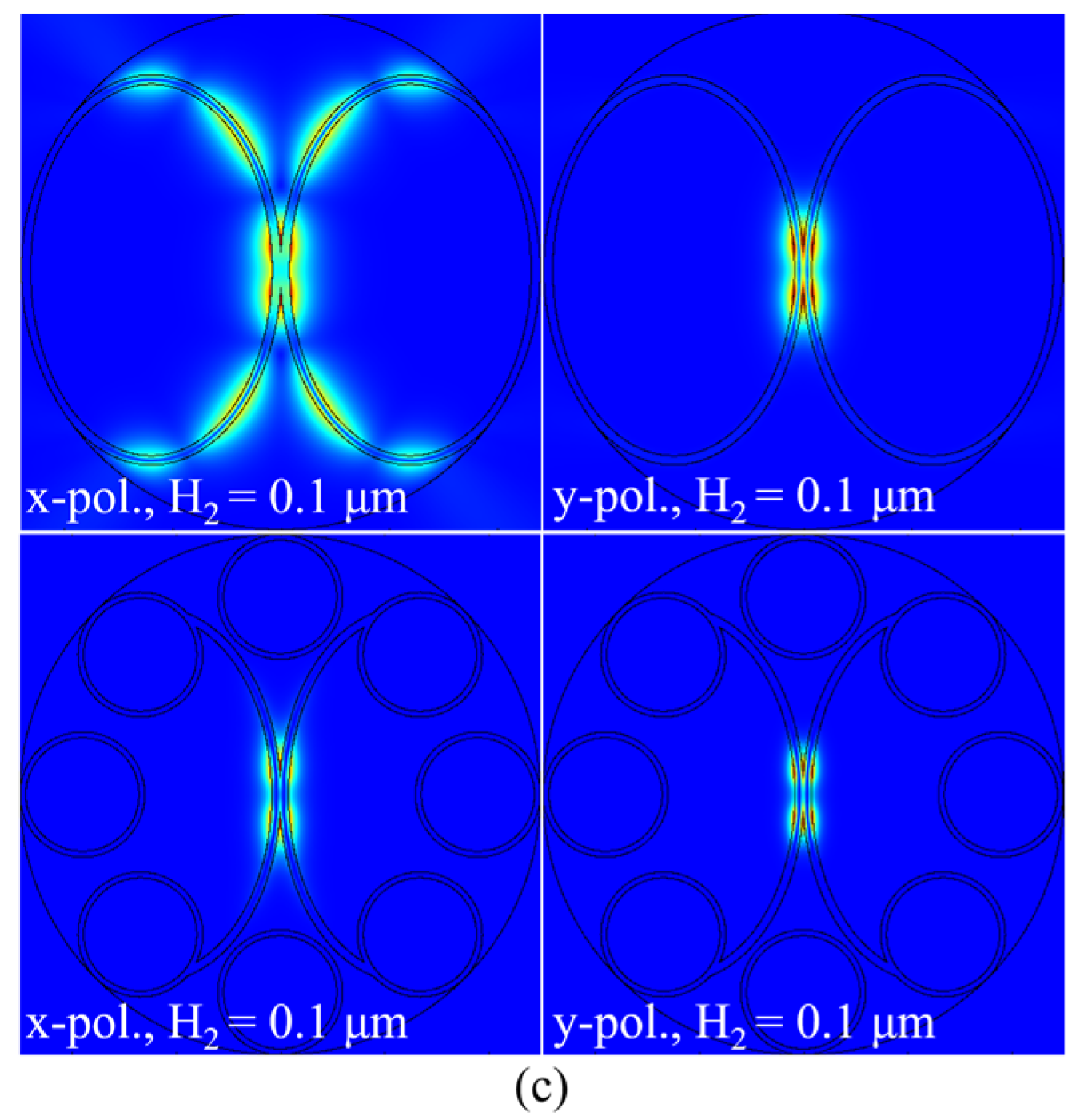
| Reference | Light Guiding Mechanism | Type of Fiber Core | Wavelength | Birefringence | Minimum CL |
|---|---|---|---|---|---|
| [2] | Index-guiding mechanism | Solid core | 1.55 μm | 2.1 × 10−2 | 9.10 × 10−5 dB/m |
| [3] | 1.55 μm | 2.2 × 10−2 | <10−6 dB/m | ||
| [4] | 1.55 μm | 1.7 × 10−2 | ~1.0 × 10−8 dB/m | ||
| [5] | 1.55 μm | 1.46 × 10−2 | 6.10 × 10−6 dB/m | ||
| [6] | 1.55 μm | 3.11 × 10−2 | — | ||
| [7] | 1.55 μm | 2.02 × 10−2 | 9.67 × 10−5 dB/m | ||
| [14] | PBG-guiding mechanism | Hollow core | 1.55 μm | <1.0 × 10−3 | — |
| [17] | 1.533 μm | 2.5 × 10−4 | <0.01 dB/m | ||
| [1] | AR-guiding mechanism | Hollow core | 1.55 μm | 1.4 × 10−4 | 0.075 dB/m |
| [9] | 1.55 μm | ~1.5 × 10−4 | 0.04 dB/m | ||
| [13] | 1.55 μm | 1.3 × 10−5 | 0.02 dB/m | ||
| [19] | 1.55 μm | 3.07 × 10−4 | 8.90 × 10−4 dB/m | ||
| [10] | Hybrid-guiding mechanism | Hollow core | 1.55 μm | 3.35 × 10−3 | 6.20 × 10−5 dB/m |
| This work | 1.55 μm | 2.31 × 10−2 | 1.85 × 10−4 dB/m |
Disclaimer/Publisher’s Note: The statements, opinions and data contained in all publications are solely those of the individual author(s) and contributor(s) and not of MDPI and/or the editor(s). MDPI and/or the editor(s) disclaim responsibility for any injury to people or property resulting from any ideas, methods, instructions or products referred to in the content. |
© 2023 by the authors. Licensee MDPI, Basel, Switzerland. This article is an open access article distributed under the terms and conditions of the Creative Commons Attribution (CC BY) license (https://creativecommons.org/licenses/by/4.0/).
Share and Cite
Liu, X.; Luo, W.; Jiang, X.; Zhang, B. Highly Birefringent and Low-Loss Hollow-Core Anti-Resonant Fiber Based on a Hybrid Guidance Mechanism. Photonics 2023, 10, 525. https://doi.org/10.3390/photonics10050525
Liu X, Luo W, Jiang X, Zhang B. Highly Birefringent and Low-Loss Hollow-Core Anti-Resonant Fiber Based on a Hybrid Guidance Mechanism. Photonics. 2023; 10(5):525. https://doi.org/10.3390/photonics10050525
Chicago/Turabian StyleLiu, Xu’an, Weixuan Luo, Xiaogang Jiang, and Bin Zhang. 2023. "Highly Birefringent and Low-Loss Hollow-Core Anti-Resonant Fiber Based on a Hybrid Guidance Mechanism" Photonics 10, no. 5: 525. https://doi.org/10.3390/photonics10050525
APA StyleLiu, X., Luo, W., Jiang, X., & Zhang, B. (2023). Highly Birefringent and Low-Loss Hollow-Core Anti-Resonant Fiber Based on a Hybrid Guidance Mechanism. Photonics, 10(5), 525. https://doi.org/10.3390/photonics10050525





